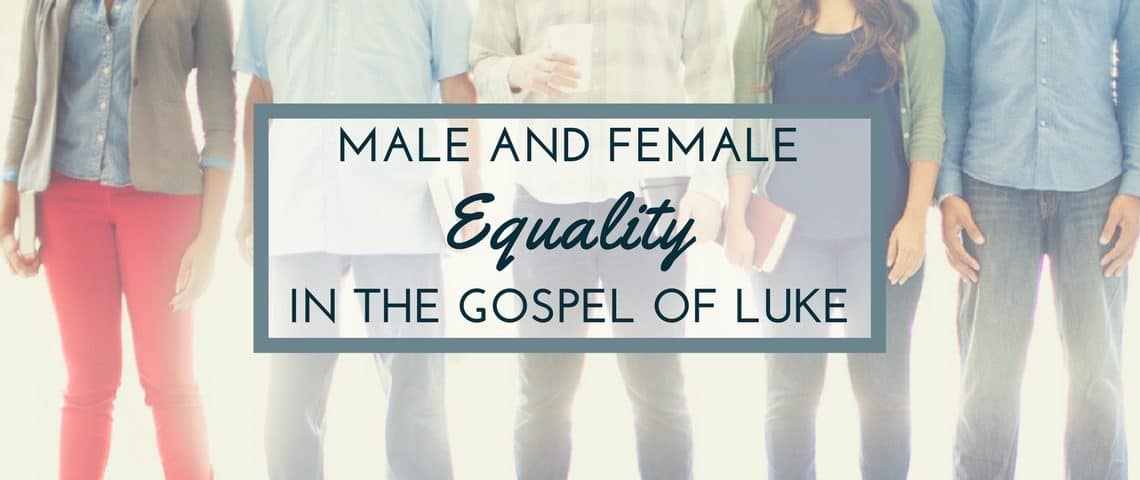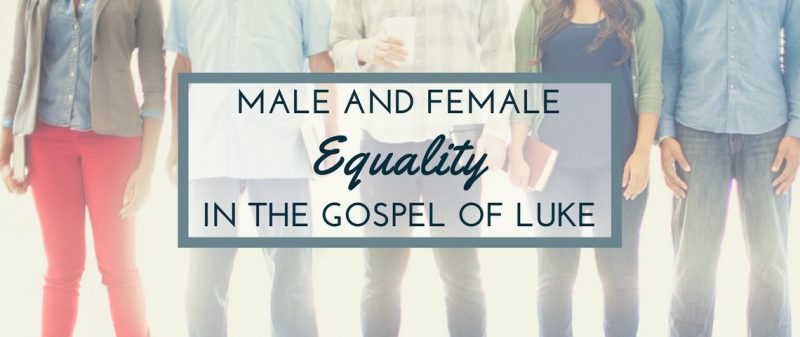Christians who don’t believe in restricting women’s roles are often unfairly accused of not valuing scripture. I think the opposite is true. The egalitarian perspective takes the whole bible into account in interpreting God’s design for how men and women should relate to each other – its words, authors, historical and cultural context, themes and patterns, and redemptive trajectory.
When we view scripture from the 30,000 foot level we see it moving in the direction of a more equal partnership of men and women, defying the convention of the times. The male-female pairings in the book of Luke are one intriguing example of this movement.
4 Ways Luke is Unique
Justo Gonzalez notes that Luke is unique in four ways. First, the extensiveness of Luke’s writing surpasses that of John and rivals the apostle Paul. Luke wrote both the Gospel of Luke and the Acts of the Apostles. In my NRSV bible, Luke’s writings take up 63 pages while Paul’s take up 60 pages and John’s take up 45.
Second, it is commonly accepted that the author is the same Luke referenced by Paul in Col 4:14 (Luke, the beloved physician) and in 2 Timothy 4 (only Luke is with me). Luke had a close relationship with the Apostle Paul and traveled extensively with him. If we really want to understand Paul, Luke can inform us more fully.
Third, Luke’s gospel is more expansive than the others, and so we learn more about Jesus. We find stories that are not included elsewhere or are abbreviated in other books (Mary and Martha, Zaccheus). And some parables only show up in Luke, like the Good Samaritan and the Prodigal Son.
Finally, women are featured more prominently in Luke’s gospel. From the birth stories to the resurrection account we see the intentional inclusion of women alongside men. This is made evident though the use of male-female pairings in the narrative and in Jesus’s public ministry.
I first learned about this interesting literary structure in the article Gendered Pairs and Parallelism in Luke’s Gospel by Marg Mowczko, who suggests that Luke “gender-paired” people, parables, and points in order to highlight an important principle concerning gender.
So here are some examples – a closer reading reveals many more, suggesting the pattern was intentional.
1. Male-female pairings in the narratives.
Luke 1 – Elizabeth and Zechariah, Mary and Joseph. Note that the women function as independent agents of God in these narratives.
Luke 2 – Simeon and Anna. These two represent different facets of the nation of Israel, both giving prophetic words about Jesus.
Luke 8 – The Twelve and Certain Women. Luke tells us that the band of disciples who traveled with Jesus included both women and men. (This is referenced again in Acts 1:14.)
Luke 23:50-56 – Joseph of Arimathea and “the women who followed Jesus from Galilee” are both at the burial of Jesus.
Luke 24:1-12 – Both male and female disciples are witnesses of the resurrection.
2. Gender inclusion in the performing of miracles.
In Luke we find three gender-paired accounts of healing. (Another can be found in the Acts 9 account of Aeneas and Dorcas.)
Luke 4:31-39 – the healing of the demon-possessed man is followed by the healing of Simon Peter’s mother-in-law.
Luke 7:1-17 – the healing of a Centurion’s slave is followed by the resurrection of the Widow of Nain’s son.
Luke 13:10-17 & 14:1-6 – the healing of a woman on the Sabbath is followed by the healing of a man on the Sabbath.
3. Gender symmetry of the parables
Luke 13:18-21 – here are two parables that describe the Kingdom of God; the man planting the mustard seed in his garden paired with the woman working the yeast through her bread dough.
Luke 15:3-10 – here are two parables that describe the love of God: the male shepherd searching for one lost sheep paired with the woman searching for a lost coin.
4. Gender inclusion in Jesus’s public teaching & discourse
Because Jesus preached to mostly mixed-gender audiences, he often used phrases like “men and women,” “husbands and wives,” “fathers and mothers,” “sons and daughters”. He also incorporated illustrations in his teaching that both sexes could identify with. For example:
Luke 4:25-27 – Jesus references both the widow at Zarephath and Naaman the Syrian to make a teaching point.
Luke 11:29-32 – Jesus uses both Jonah and the Queen of Sheba as examples.
Jesus was inclusive of women and modeled this for men.
Apparently, this intentionality made a lasting impact on those around him, since it is preserved in the gospel of Luke through this literary structure. Ben Witherington III suggests the male-female pairings in Luke serve as a reminder that men and women are both equal recipients of God’s grace and equal participants in God’s mission. He believes Luke makes an “attempt to present women in a new light, as an oppressed group set free by the fulfillment of Isaiah 6:1-2 in the ministry of Jesus”.
Also consider that this inclusion of women is highly unusual for literature of this time. We can imagine that the women hearing or reading Luke may have questioned whether this good news was really for them or only for the men. The intentional use of gender pairs suggests that Luke wants to make sure women know they are viewed as equal partners in ministry.
A New Paradigm
Forbes and Harrower observe that “In Luke it appears that God is relating to women in a new way. In a like manner, women relate to God, God’s people, God’s word, and God’s mission in a new way“.
This literary device of male-female pairings in Luke shows us that Jesus modeled respect for women and encouraged their participation as disciples without distinctions based on gender.
[Click HERE for a Spanish translation of this post]
References
Forbes, G, Harrower, S. 2015. Raised from Obscurity: A Narratival and Theological Study of the Characterization of Women in Luke-Acts. Eugene, OR: Pickwick Press.
Gonzalez, J.L. 2015. The Story Luke Tells: Luke’s Unique Witness to the Gospel. Grand Rapids: Eerdmans.
Witherington, B. 1984. Women in the Ministry of Jesus: A Study of Jesus’ Attitudes to Women and their Roles as Reflected in his Earthly Life. Cambridge: Cambridge University Press.
Witherington, B. 1990. Women and the Genesis of Christianity. Cambridge: Cambridge University Press.
Note: Male-female pairings in other gospels include Matthew 6:26 & 28, 24: 40-41, Mark 2:21, John 3-4.
See also Gendered Pairs and Parallelism in Luke’s Gospel and Pairs of Stories in Luke
Image credit: Lightstock





15 responses to “Male-Female: Equality in the Gospel of Luke”
Great post here Gail. It’s almost as if Luke wove this gender-pairing dynamic into his gospel in a sneaky, or subversive way, such that only those who are seeking with an open heart would find it. Reminds me of the secret of the Kingdom passage in Luke 8; when the disciples seek understanding, they get it!
Gail, Luke clearly wrote of the inclusive nature of the gospel, which puts the lie to the marginalization that people still try to promote. How they can read the whole of Scripture and come to the conclusion that women are off tot eh side while men are front and center under the New Covenant is beyond me. Of course, they will deny they marginalize women but their teachings do just that: women end up taking a back seat to men under that patriarchal mindset.
P.S. Your opening line on whether egalitarians read the Bible carefully and faithfully reminded me of the meme in this post: Being Egalitarian and Taking the Bible Seriously.
I loved this, Gail! Thanks. I am looking forward to combing through Luke again with eyes in search of these pairs
great insight
Excelente articulo. Muchas gracias. Es una visión amplia y de mente abierta.
Muchas gracias por sus comentarios!
Don’t forget John’s Gospel where Nicodemus a Pharisee leader comes to Jesus at night and still does not understand how to be born again by the Spirit. In the next chapter is the nameless Samaritan woman who comes to Jesus at noon day; she gets it and evangelized her neighborhood. A strong contrast of how the Gospel was embraced by women.
YES! I have that in a note after the References but should probably move it up closer to the body of the post. Thank you!
These parallelisms shine an important light on the role of women in the gospel stories; a role that has too often and for too long been overlooked.
Agreed, Carrie. Too many seem to take a myopic view and miss the forest for the trees!
Very interesting.
Could I translate it in French for my blog?
Blessings.
Désiré
Please do! Just include a link back to the original post. Thank you!